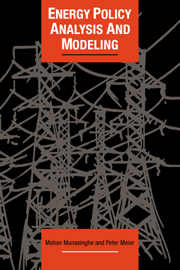Book contents
7 - Energy-environmental interactions
Published online by Cambridge University Press: 05 March 2012
Summary
Energy is at the very center of many of the current concerns over the global environment and the degradation of local, regional, and national environments. While it is perhaps true that environmental issues have not heretofore occupied a prominent part in developing country energy planning, that situation is changing very quickly. Even aside from purely indigenous concerns over the impact of major energy projects, the International Financial Institutions have begun to pay much more attention to the environmental impacts of major projects than in the past. Moreover, one need only examine the experience of the developed countries in this respect to get some idea of what is to come elsewhere: in the United States, for example, environmental considerations have greatly influenced efforts to change the energy mix from imported oil to domestic coal, domestic oil, and nuclear energy. Epic legislative and legal battles have been fought over conflicts between legislation and programs to promote domestic energy use at the expense of imported oil (such as the Fuel Use Act that sought to increase coal utilization, or the Federal leasing programs for off-shore oil development), and those designed to protect the environment (of which the Clean Air and Water Acts, and the National Environmental Policy Act, are the most important). In the larger developing countries, where the scale of energy resource extraction and air pollution has reached significant levels, environmental concerns are already beginning to influence significantly national and regional energy policies. The environmental impacts of the huge increase in coal output for power generation and industrial boilers in India and China, or the impacts of large-scale hydro development in Brazil and India, are testimony to such trends.
- Type
- Chapter
- Information
- Energy Policy Analysis and Modelling , pp. 97 - 134Publisher: Cambridge University PressPrint publication year: 1993



